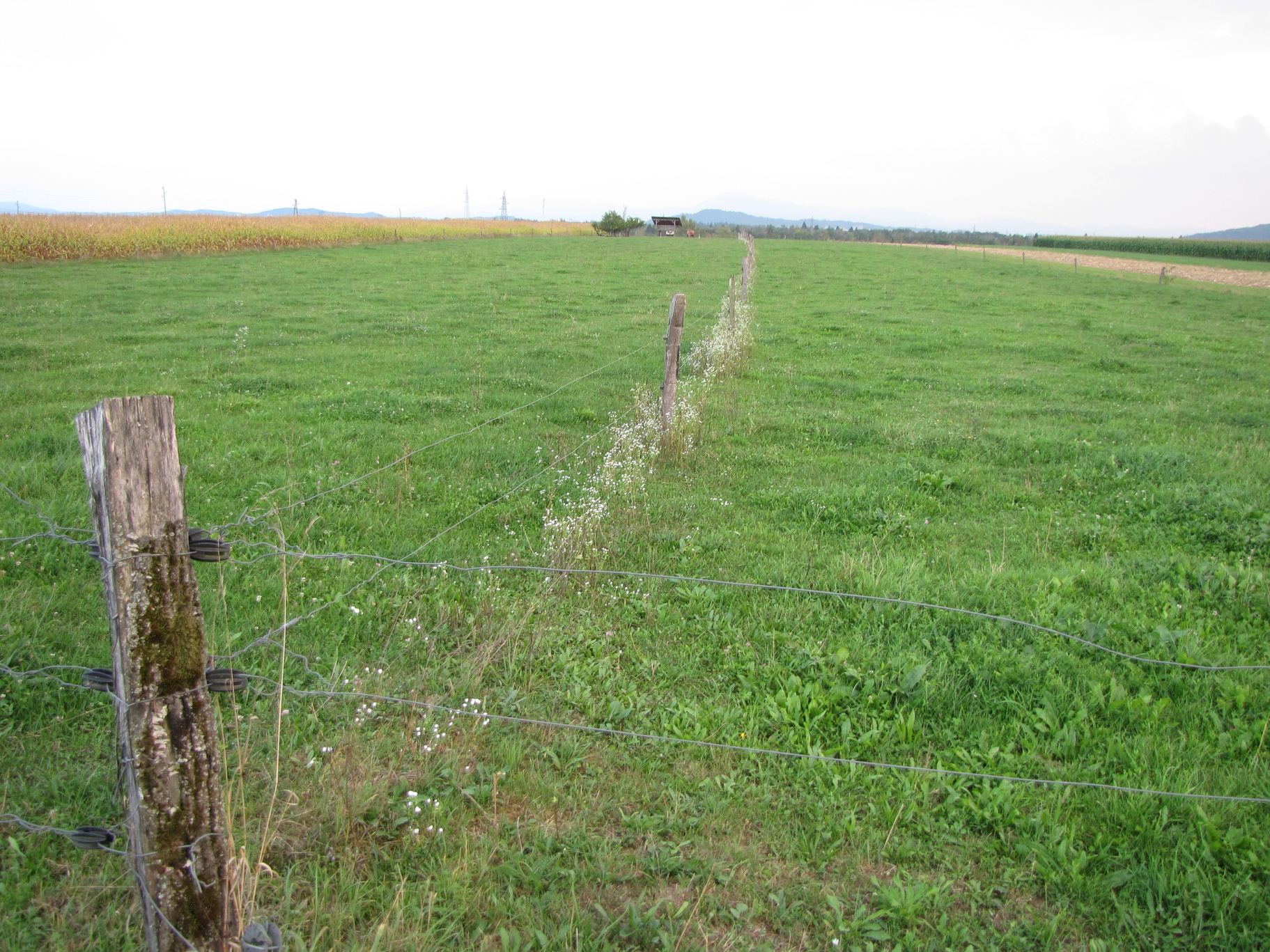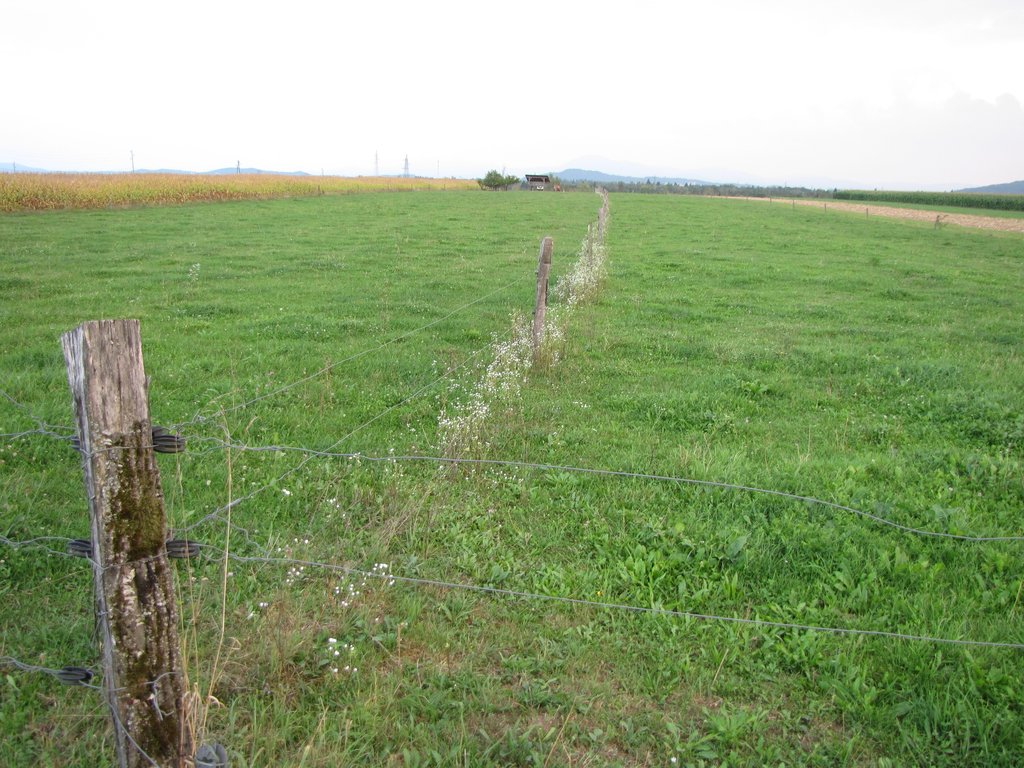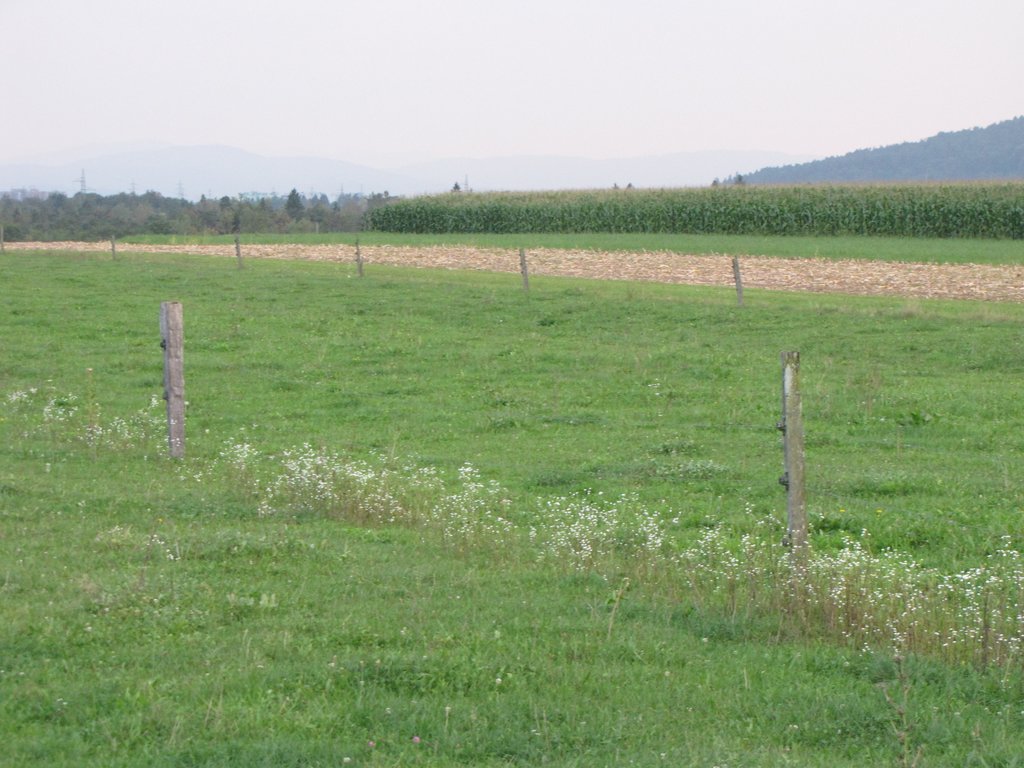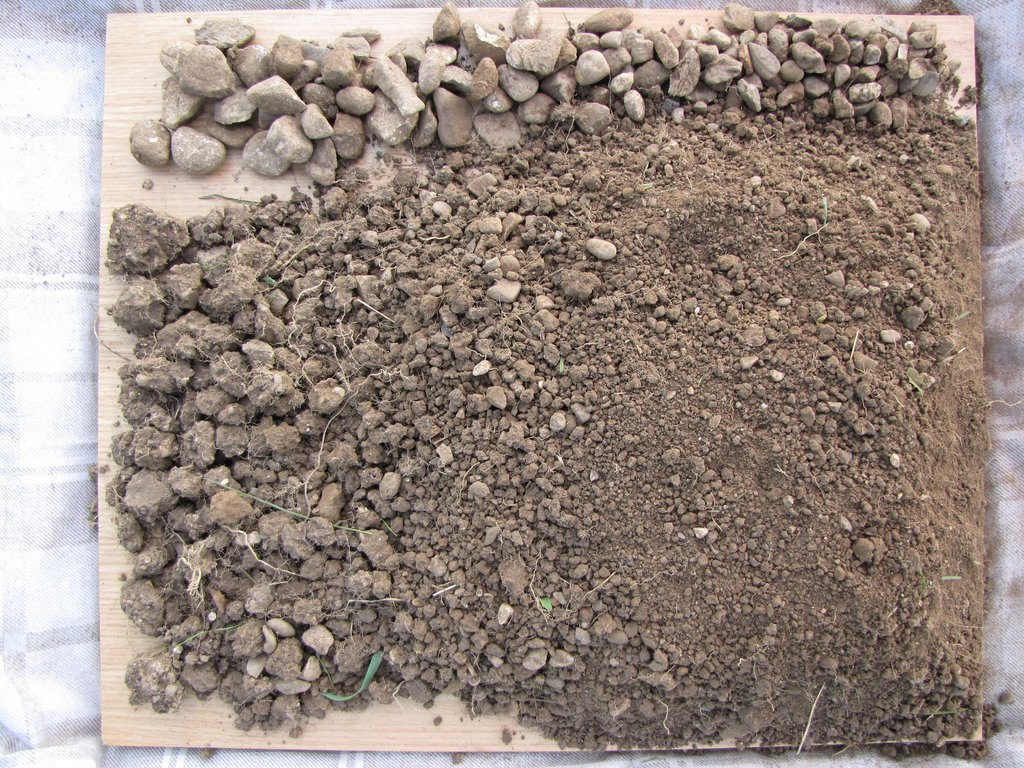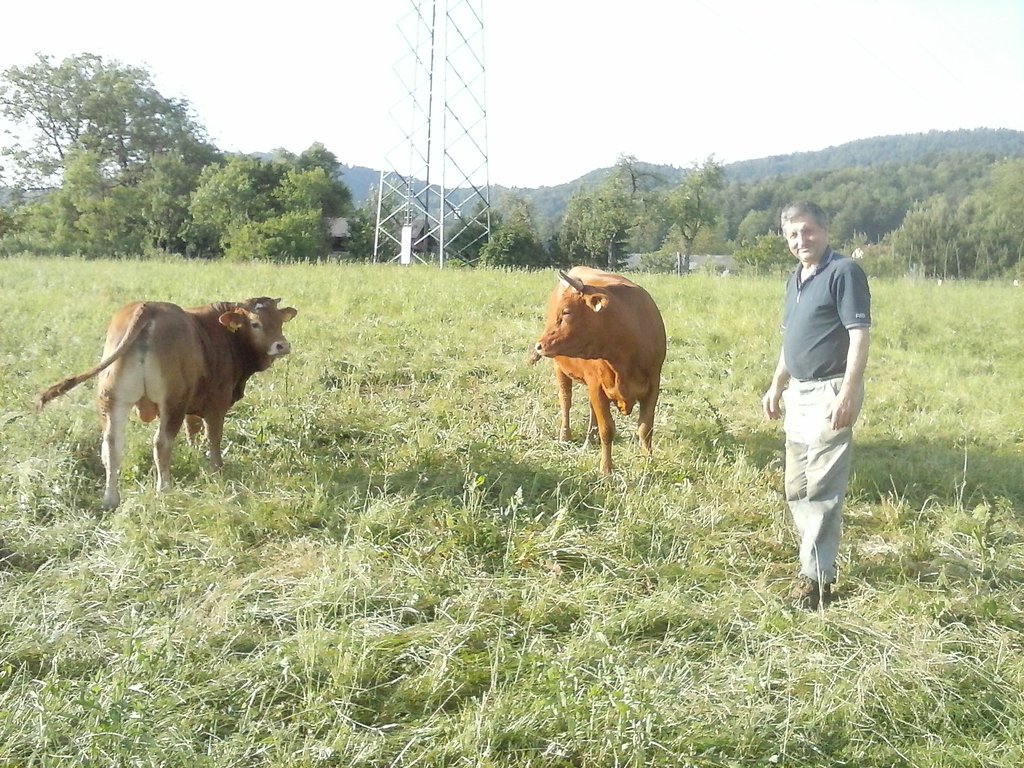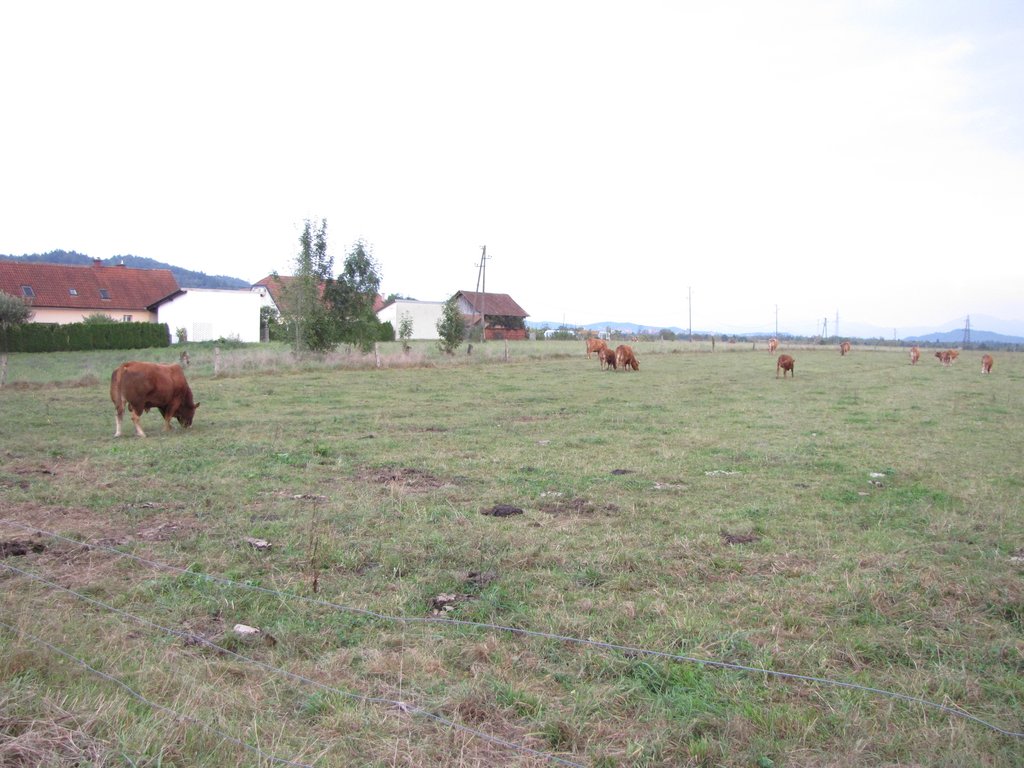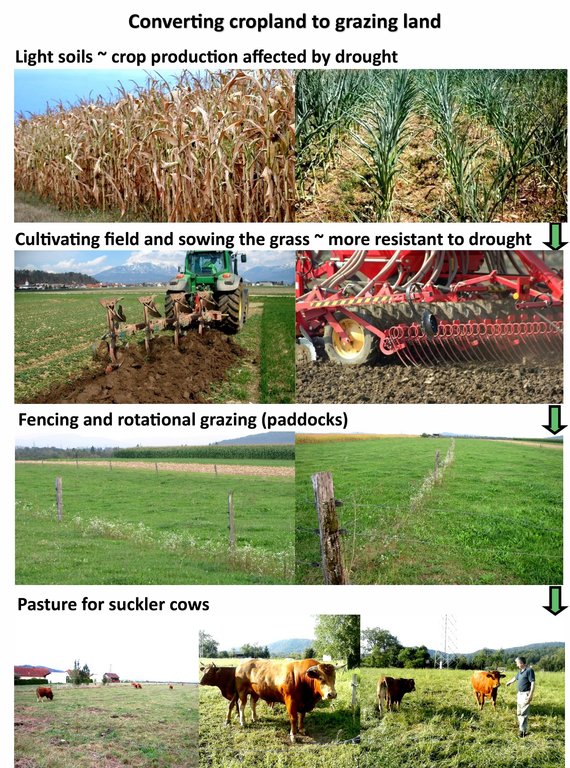Converting cropland to grazing land [斯洛文尼亚]
- 创建:
- 更新:
- 编制者: Matjaz Glavan
- 编辑者: –
- 审查者: Ursula Gaemperli, Gudrun Schwilch
Pretvorba njiv v pašnike
technologies_2823 - 斯洛文尼亚
查看章节
全部展开 全部收起1. 一般信息
1.2 参与该技术评估和文件编制的资源人员和机构的联系方式
有助于对技术进行记录/评估的项目名称(如相关)
Interactive Soil Quality assessment in Europe and China for Agricultural productivity and Environmental Resilience (EU-iSQAPER)有助于对技术进行记录/评估的机构名称(如相关)
Department for Agronomy, University of Ljubljana - 斯洛文尼亚1.3 关于使用通过WOCAT记录的数据的条件
(现场)数据是什么时候汇编的?:
08/06/2017
编制者和关键资源人员接受有关使用通过WOCAT记录数据的条件。:
是
1.4 所述技术的可持续性声明
这里所描述的技术在土地退化方面是否存在问题,导致无法被认为是一种可持续的土地管理技术?:
否
注释:
Prevenets exposure of soils to drought.
2. SLM技术的说明
2.1 技术简介
技术定义:
Technology is based on changing cropland to grazing land due to shallow soils with high share of rocks. This is the cause for lower yields or loss of yield during drought periods.
2.2 技术的详细说明
说明:
1.The technology is applied in flatlands of Ljubljana with an average altitude of 350 m.a.s.l. The average annual precipitation is 1400 mm. The area is characterized with often stormy precipitation events and occasional droughts. Silty loam soils in the area are moderately deep to deep with medium soil organic matter. Area has good availability of surface water and groundwater of good drinking quality. Area has medium biodiversity without salinity and flooding problems. Sedentary agriculture with mixed or commercial agriculture is practiced with less than 10% of income from off-farm. Individual farm households are average in wealth and they are basically mechanized/motorized. The examined farm household, as all housholds in the region has good access to all services and infrastructures. Farm is medium in scale with land owned partly by the farmer and partly leased from other private owners.
2. Cropland area was converted to permanent grassland or pasture land by sowing of grass and by a fence as protection. Grazing is organized in a rotation system between suckler cow's pasture and paddocks.
3. The purpose of the technology is to use the natural potential of the soils. As soils are shallow with low water holding capacity permanent grassland is much more resilient and adapted to the drought; permanent grassland needs not only less water, but as well less nutrients. Grass has the capacity to grow well after any rainfall event at any time of the growing period. During drought when, maize fields get dry, grasslands subsist and just wait until the rain falls. While maize yield is lost in drought years, grassland can sustain and nurrish animals until mid-autumn. Another advantage of grassland is its building up of organic matter in the soils.
4. Main activities to establish the grazing fields are fences and electricity instalments together with grass sowing. Main maintenance activities are regular checking of the fence and electricity power and regular cleaning cuts to remove the weed at least once a year.
5. Benefits are:
(1) soils are less exposed to adverse weather conditions like drought
(2) increase of soil organic matter
(3) better resilience of the land user against production loss
(4) rise of soil biodiversity
(5) better animal welfare
(6) land user benefit from growing customer interest for meat products.
6. Land users like this better use of land resources, as less productive soils have gained new meaning. But they, on the other hand, also blame the loss of cropland needed for their maize production.
2.3 技术照片
2.5 已应用该技术的、本评估所涵盖的国家/地区/地点
国家:
斯洛文尼亚
有关地点的进一步说明:
Municipality of Ljubljana
Map
×2.6 实施日期
注明实施年份:
2000
如果不知道确切的年份,请说明大概的日期:
- 10-50年前
2.7 技术介绍
详细说明该技术是如何引入的:
- 通过土地使用者的创新
3. SLM技术的分类
3.1 该技术的主要目的
- 改良生产
- 减少、预防、恢复土地退化
- 保持/提高生物多样性
- 适应气候变化/极端天气及其影响
- 创造有益的经济影响
3.2 应用该技术的当前土地利用类型

牧场
集约放牧/饲料生产:
- 改良牧场
主要动物种类及产品:
suckler cows for fresh meat production
如果由于技术的实施而导致土地用途发生变化,则在技术实施前说明土地利的用途。:
Previous land use was cropland (silage maize/cereals/alfalfa).
3.3 有关土地利用的更多信息
该技术所应用土地的供水:
- 雨养
每年的生长季节数:
- 1
3.4 该技术所属的SLM组
- 畜牧业和牧场管理
3.5 技术传播
具体说明该技术的分布:
- 均匀地分布在一个区域
如果该技术均匀地分布在一个区域上,请注明覆盖的大致区域。:
- < 0.1 平方千米(10 公顷)
3.6 包含该技术的可持续土地管理措施

管理措施
- M1:改变土地使用类型
3.7 该技术强调的主要土地退化类型

化学性土壤退化
- Cn:肥力下降和有机质含量下降(非侵蚀所致)

物理性土壤退化
- Pc:压实

生物性退化
- Bh:栖息地丧失
- Bq:数量/生物量减少
- Bp:害虫/疾病增加,捕食者减少
3.8 防止、减少或恢复土地退化
具体数量名该技术与土地退化有关的目标:
- 防止土地退化
- 减少土地退化
4. 技术规范、实施活动、投入和成本
4.1 该技术的技术图纸
4.2 技术规范/技术图纸说明
Technical infographic presents reason for land use conversion (loss of yield due to drought on shallow, sandy soils) and process of conversion from ploughing, sowing, fencing and pasture establishment.
4.3 有关投入和成本计算的一般信息
具体说明成本和投入是如何计算的:
- 每个技术区域
注明尺寸和面积单位:
12 hectares
其它/国家货币(具体说明):
EUR (€)
注明美元与当地货币的汇率(如相关):1美元=:
0.89
注明雇用劳工的每日平均工资成本:
50
4.4 技术建立活动
| 活动 | 措施类型 | 时间 | |
|---|---|---|---|
| 1. | Land preparation | 农业学的 | vegetational period |
| 2. | Grass sowing | 植物性的 | All year arround, before fencing. |
| 3. | Fence installation | 管理 | winter, spring |
4.5 技术建立所需要的费用和投入
如果可能,按下表分列技术建立费用,并列明各项投入和每项投入的费用。如果您无法分解成本,给出建立该技术的总成本估算。:
7.0
| 对投入进行具体说明 | 单位 | 数量 | 单位成本 | 每项投入的总成本 | 土地使用者承担的成本% | |
|---|---|---|---|---|---|---|
| 劳动力 | Fence installation | EUR/hour | 20.0 | 6.25 | 125.0 | 100.0 |
| 劳动力 | Land preparation | EUR/hour | 2.0 | 6.25 | 12.5 | 100.0 |
| 设备 | Fence (pillars, wires and electric fence energiser) | EUR/ha | 3.0 | 266.0 | 798.0 | 100.0 |
| 植物材料 | grass seeds | EUR/ha | 3.0 | 200.0 | 600.0 | 100.0 |
| 技术建立所需总成本 | 1535.5 | |||||
注释:
The fence system has to be renovated every 10 years.
4.6 维护/经常性活动
| 活动 | 措施类型 | 时间/频率 | |
|---|---|---|---|
| 1. | Fence maintenance | 管理 | all year around |
4.7 维护/经常性活动所需要的费用和投入(每年)
| 对投入进行具体说明 | 单位 | 数量 | 单位成本 | 每项投入的总成本 | 土地使用者承担的成本% | |
|---|---|---|---|---|---|---|
| 劳动力 | Checking the fence | EUR/hour | 8.0 | 6.25 | 50.0 | 100.0 |
| 设备 | electrical isolators for wooden pillars | pcs | 100.0 | 0.2 | 20.0 | 100.0 |
| 技术维护所需总成本 | 70.0 | |||||
注释:
The fence system has to be renovated every 10 years.
4.8 影响成本的最重要因素
描述影响成本的最决定性因素:
Costs for fence establishment and electric fence energiser.
5. 自然和人文环境
5.1 气候
年降雨量
- < 250毫米
- 251-500毫米
- 501-750毫米
- 751-1,000毫米
- 1,001-1,500毫米
- 1,501-2,000毫米
- 2,001-3,000毫米
- 3,001-4,000毫米
- > 4,000毫米
指定年平均降雨量(若已知),单位为mm:
1352.00
有关降雨的规范/注释:
Average annual precipitation period is 1991-2000.
Majority of the rain falls in the autumn, followed by summer, spring and winter.
注明所考虑的参考气象站名称:
Ljubljana-Bežigrad
农业气候带
- 半湿润
strong summer tunder storms and showers with local precipitation.
5.2 地形
平均坡度:
- 水平(0-2%)
- 缓降(3-5%)
- 平缓(6-10%)
- 滚坡(11-15%)
- 崎岖(16-30%)
- 陡峭(31-60%)
- 非常陡峭(>60%)
地形:
- 高原/平原
- 山脊
- 山坡
- 山地斜坡
- 麓坡
- 谷底
垂直分布带:
- 0-100 m a.s.l.
- 101-500 m a.s.l.
- 501-1,000 m a.s.l.
- 1,001-1,500 m a.s.l.
- 1,501-2,000 m a.s.l.
- 2,001-2,500 m a.s.l.
- 2,501-3,000 m a.s.l.
- 3,001-4,000 m a.s.l.
- > 4,000 m a.s.l.
说明该技术是否专门应用于:
- 不相关
5.3 土壤
平均土层深度:
- 非常浅(0-20厘米)
- 浅(21-50厘米)
- 中等深度(51-80厘米)
- 深(81-120厘米)
- 非常深(> 120厘米)
土壤质地(表土):
- 粗粒/轻(砂质)
- 中粒(壤土、粉土)
土壤质地(地表以下> 20厘米):
- 粗粒/轻(砂质)
- 中粒(壤土、粉土)
表土有机质:
- 中(1-3%)
5.4 水资源可用性和质量
地下水位表:
5-50米
地表水的可用性:
中等
水质(未处理):
良好饮用水
水的盐度有问题吗?:
否
该区域正在发生洪水吗?:
否
5.5 生物多样性
物种多样性:
- 中等
栖息地多样性:
- 中等
5.6 应用该技术的土地使用者的特征
定栖或游牧:
- 定栖的
生产系统的市场定位:
- 混合(生计/商业
非农收入:
- 收入的10-50%
相对财富水平:
- 平均水平
个人或集体:
- 个人/家庭
机械化水平:
- 机械化/电动
性别:
- 男人
土地使用者的年龄:
- 中年人
5.7 应用该技术的土地使用者拥有或租用的平均土地面积
- < 0.5 公顷
- 0.5-1 公顷
- 1-2 公顷
- 2-5公顷
- 5-15公顷
- 15-50公顷
- 50-100公顷
- 100-500公顷
- 500-1,000公顷
- 1,000-10,000公顷
- > 10,000公顷
这被认为是小规模、中规模还是大规模的(参照当地实际情况)?:
- 中等规模的
5.8 土地所有权、土地使用权和水使用权
土地所有权:
- 个人,未命名
- 个人,有命名
土地使用权:
- 租赁
- 个人
用水权:
- 个人
5.9 进入服务和基础设施的通道
健康:
- 贫瘠
- 适度的
- 好
教育:
- 贫瘠
- 适度的
- 好
技术援助:
- 贫瘠
- 适度的
- 好
就业(例如非农):
- 贫瘠
- 适度的
- 好
市场:
- 贫瘠
- 适度的
- 好
能源:
- 贫瘠
- 适度的
- 好
道路和交通:
- 贫瘠
- 适度的
- 好
饮用水和卫生设施:
- 贫瘠
- 适度的
- 好
金融服务:
- 贫瘠
- 适度的
- 好
- 贫瘠
- 适度的
- 好
6. 影响和结论性说明
6.1 该技术的现场影响
社会经济效应
生产
饲料生产
饲料质量
土地管理
收入和成本
农业投入费用
农业收入
收入来源的多样性
工作量
注释/具体说明:
Animals have their own requirements. They need drinking water, they need to be relocated, daily observed and watch over in case of broken fence. Thus, the simplified management is not leading to a decrease of workload
生态影响
土壤
土壤水分
土壤压实
注释/具体说明:
On light soils there is no differences. On clay soils it is rather worse.
生物多样性:植被、动物
植物多样性
有益物种
减少气候和灾害风险
干旱影响
6.2 该技术的场外影响已经显现
地下水/河流污染
6.3 技术对渐变气候以及与气候相关的极端情况/灾害的暴露和敏感性(土地使用者认为的极端情况/灾害)
渐变气候
渐变气候
| 季节 | 气候变化/极端天气的类型 | 该技术是如何应对的? | |
|---|---|---|---|
| 年温度 | 增加 | 适度 |
6.4 成本效益分析
技术收益与技术建立成本相比如何(从土地使用者的角度看)?
短期回报:
积极
长期回报:
积极
技术收益与技术维护成本/经常性成本相比如何(从土地使用者的角度看)?
短期回报:
积极
长期回报:
积极
6.5 技术采用
- 大于 50%
在所有采用这项技术的人当中,有多少人是自发地采用该技术,即未获得任何物质奖励/付款?:
- 90-100%
6.6 适应
最近是否对该技术进行了修改以适应不断变化的条件?:
否
6.7 该技术的优点/长处/机会
| 土地使用者眼中的长处/优势/机会 |
|---|
|
Strengths: less grass cutting in summer time as animals are grazing. Lower costs of production. |
| Advantages: animal welfare. |
| Opportunities: diversified landscape view is an additional value. |
| 编制者或其他关键资源人员认为的长处/优势/机会 |
|---|
|
Strengths: better use of soil /land resource. Crop like maize would bring low yields and high costs. |
| Advantages: animal welfare / better conditions and increase in biodiversity. |
| Opportunities: adaptation to rising drought events. |
6.8 技术的弱点/缺点/风险及其克服方法
| 土地使用者认为的弱点/缺点/风险 | 如何克服它们? |
|---|---|
|
Weaknesses: transport of animals to the pasture in spring time. |
They use lorry for transport. |
| Disadvantages: different parasites influencing animal health. | Regular use of medicine in risk areas. |
| Risks: soil compaction on heavy clay soils. | Lower density of animals. |
| 编制者或其他关键资源人员认为的弱点/缺点/风险 | 如何克服它们? |
|---|---|
| Weaknesses: soil compaction; overgrazing with soil exposure to external weather conditions. | Livestock density is crucial to maintain good land management. |
7. 参考和链接
7.1 信息的方法/来源
- 实地考察、实地调查
1
- 与土地使用者的访谈
1 informant
链接和模块
全部展开 全部收起链接
无链接
模块
无模块


